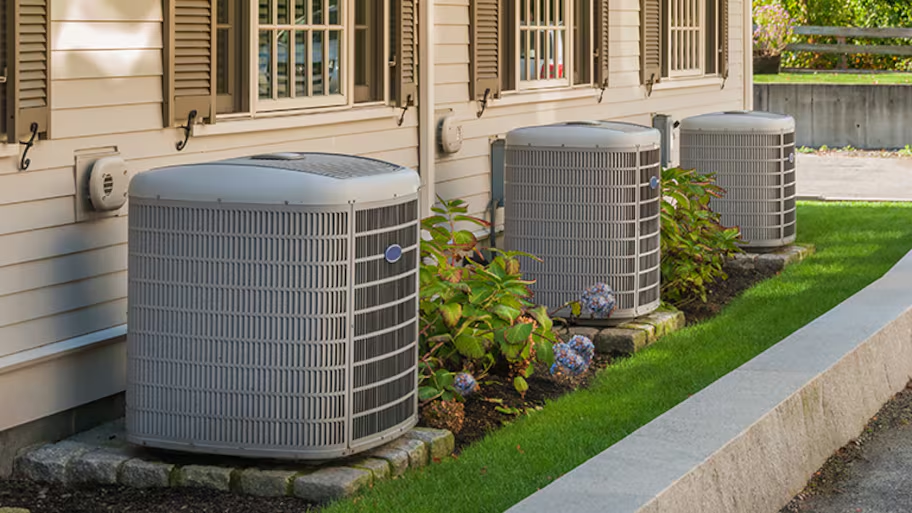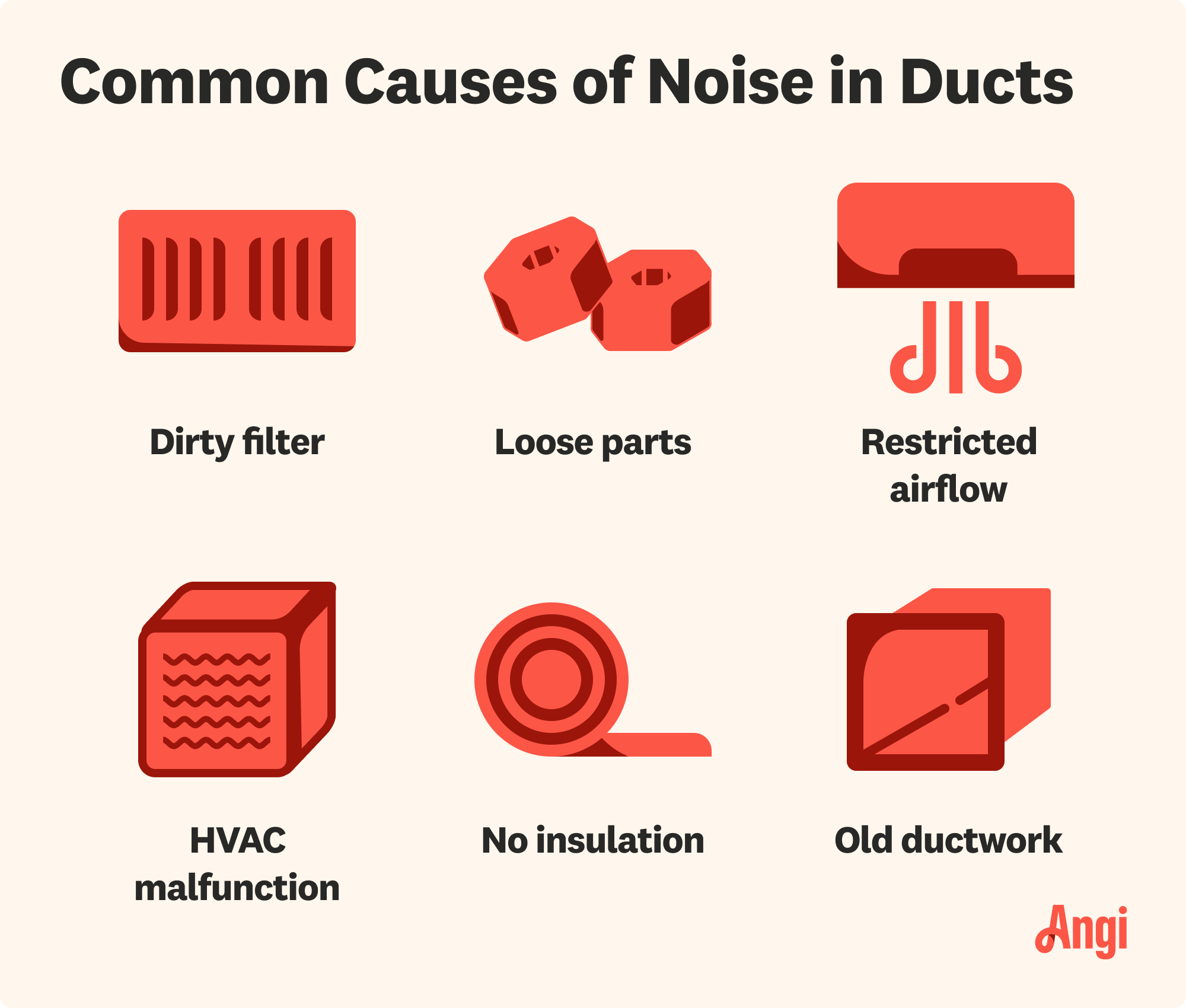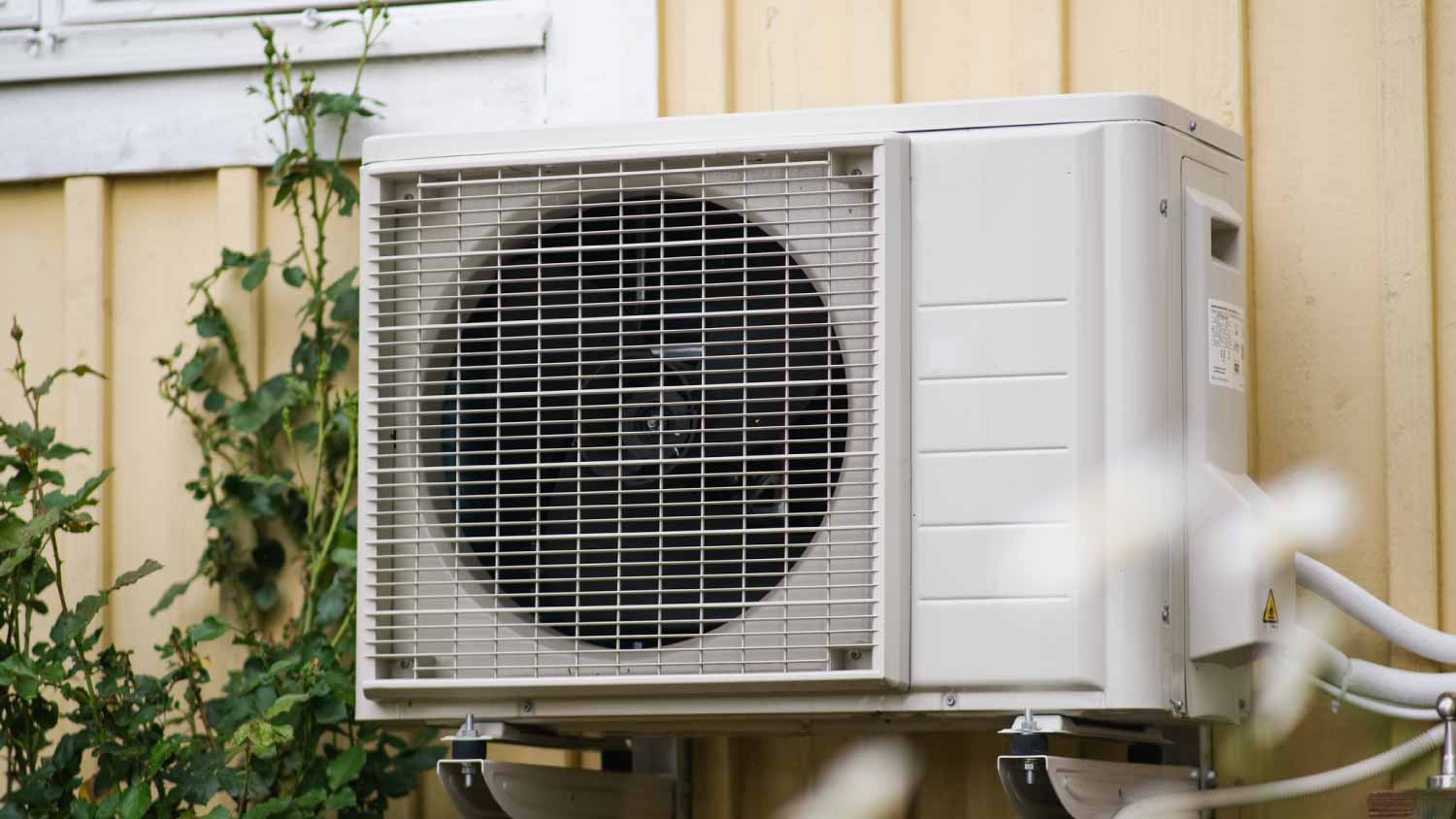
HVAC replacement costs depend on a lot of factors, like unit type, size, and labor. See what you can expect to pay for HVAC replacement here.
Silence of the ducts


Attempting complex duct repairs or replacing sections yourself risks damaging the HVAC system or creating airflow issues that can worsen noise problems.
A ductwork installation pro can identify hidden causes of noise, adjust dampers, or repair failing system parts.
Full duct repairs or replacements require specialized tools like sheet metal cutters, seamers, and HVAC testing equipment that most homeowners don’t have.
An HVAC system helps us relax in climate-controlled comfort in our homes. However, if your HVAC system is causing noisy ducts, it can be an unwelcome disturbance. Some of the most common causes of noisy ductwork include damaged material, loose connectors, dirty filters, blocked airflow, or ducts that are too small. Learn more about how to eliminate ductwork noise and regain the sweet sound of silence.

If your ductwork makes banging noises or rattling sounds, you’re not alone. Such noises could indicate anything from a very minor, easy-to-fix situation to a severe issue with the ducts or HVAC system. Some reasons for noises in the ductwork include:
Temperature changes: A few pops or bangs from the ducts are possible from sudden changes in temperature and air pressure as a furnace or air conditioner begins running.
Loose parts: Screws and brackets may work loose over time from vibration in the system. As these parts shake and loosen, they make noise and require tightening.
Restricted airflow: If a dirty furnace filter, debris in the ducts, or pests living in the ductwork are blocking air movement, it could generate noise. Old ductwork that doesn’t have the capacity to properly move the air from a new furnace or air conditioner may also cause noise.
Failing system: When parts begin to fail, such as a compressor or a blower motor, you may notice excessive noise. Such issues wouldn’t have anything to do with the ductwork, but sound waves from the faulty part could travel through the ductwork.
When trying to identify the source of ductwork noise, pay attention to a few clues.
Listen closely to the type of noise you’re hearing to receive some clues as to the problem.
If you hear rattling noises or sounds that indicate vibration, you may have a gap in the metal or a loose screw or bolt.
Banging sounds indicate loose parts, such as dampers or frames, that may be flopping around as air moves through the system.
Rumbling noises could indicate reduced airflow from blockages or a dirty air filter. They could also signal failing parts in the HVAC system.
Scratching noises could mean rodents or even a bird inside the ducts.
Occasional popping noises indicate a temperature or humidity change that’s causing expansion or contraction in the metal.

You can perform a DIY visual inspection of areas of the ductwork that you can easily reach to find the source of the noise.
If you can see some of the ductwork in your basement or attic, inspect it for loose bolts and gaps.
If you have a really powerful flashlight, place it inside the ducts. Then go into a dark basement or attic and look for any light shining through gaps in the ductwork.
Remove some vent grills and shine the flashlight in them, looking for blockages that could explain the noises.
Inspect the furnace filter for excess debris.
Stand next to the furnace while it runs and listen for unusual noise. If so, this could indicate failing parts in the furnace.
If you cannot identify the source of the noise on your own, call a professional to inspect the system. Local HVAC technicians can often inspect both the HVAC system and your ductwork to determine the source of the noise and the severity of the problem.

Changing a dirty furnace filter can fix some noise problems by allowing normal airflow to return to the system.
If you notice bolts that are loose, gaps near the seams, or loose parts crashing into each other, and if you can reach these areas safely, tighten them to reduce noise.
If you see some of the metal of the duct rubbing against framing pieces, you may be able to insert rubber pads between them. The rubber absorbs the vibration and restricts noise.
Sometimes, reducing the speed of the fan for the HVAC system lowers the noise you hear. This is only a temporary solution, though. If you cannot run your system at the desired fan speed, it could indicate a malfunction with the system that needs repair.
You may have debris inside the ducts that are causing the noise. Although significant noise from dirty ducts is unlikely, you may be able to reduce some noise by cleaning them yourself or hiring a local air duct cleaning company to do the work.
Your HVAC system and ducts have dampers inside that open and close to control airflow. If your dampers are old, they may be banging noisily as they operate. Adjust the dampers or replace them to try to fix the noise. This may require the work of an HVAC pro.
You can place insulation around the outside of your ducts in areas where you can easily access them, such as in an unfinished basement or attic. Insulation can muffle some noises generated by the ductwork.
Some HVAC pros may recommend using an insulated liner on the interior of the ducts. This liner will potentially improve temperature control while reducing noise.
If the noise comes from malfunctioning parts in the furnace or air conditioner, contact a local HVAC repair company to service the system. The noise may provide a warning about a part that will soon fail, leaving you without heating and air conditioning. A repair tech could fix the problem before the entire system fails.
If you have older ductwork that is nearing the end of its life span, replacing it may be the best solution for eliminating ductwork noises. You also may need to replace the ducts if you purchase a new HVAC system that generates more airflow than the capacity of the current ducts can handle.
Installing a new return or supply vent for the HVAC system may let you avoid a full replacement. The new bypass ductwork can alleviate pressure on the main ductwork system, which is causing the noise.
All ducts generate noise, but some sounds are cause for concern. A gentle humming or clicking is normal, but loud rattling, banging, buzzing, or whistling means you may have a problem requiring professional help. Some factors that cause excessively noisy ducts include dents or damage, loose metal parts, dirty or blocked vents, and closed dampers.
Once you eliminate the ductwork noise, you can follow a few steps to keep it from returning.
Filter: Keep the furnace filter clean by changing it on a regular schedule every few months.
Cleaning: Clean the grills and vents regularly to prevent a buildup of debris and dust that could reduce airflow.
Inspection: Conduct regular inspections—either yourself or with a pro—to look for loose sections of the ductwork that could lead to noise problems.
Service: Have a local furnace tune-up company visit your home annually to inspect the furnace for issues. The pro can repair older parts before they start generating annoying noises.
Ultimately, preventative maintenance is the best way to keep ductwork noises from returning. If you notice any noise that isn’t easily explained, such as by occasional sudden temperature or humidity changes, check out the source of the potential problem immediately.
When it comes to eliminating ductwork noise, you can potentially do some of the work yourself. More complex problems will require the help of a pro.
You can change your furnace filter as a DIY project to reduce ductwork noise. If you can easily see the ducts leading to the furnace, look for loose bolts or gaps in the seams that could explain the noise.
If you need to replace older ducts, the average air duct replacement cost is $1,250, but it can cost as much as $9,000 for a full system replacement. The size of your home has a major impact on the replacement cost, with larger homes (which have larger duct systems) having the highest replacement costs. A local ductwork installation company can provide you with an inspection and estimate prior to any repairs or replacement.
From average costs to expert advice, get all the answers you need to get your job done.

HVAC replacement costs depend on a lot of factors, like unit type, size, and labor. See what you can expect to pay for HVAC replacement here.

Discover the primary whole-house air filtration system cost factors when installing one in your home to help remove airborne contaminants and allergens.

Furnace cleaning is an essential annual chore to keep your home safe. Find out common furnace cleaning costs by type and size of furnace with this guide.

Wondering how to bleed a baseboard heater without a bleed valve? Here’s how to remove trapped air the old-fashioned way, with a boiler drain and water replacement.

Who do you call to fix a boiler? This easy guide will help you hire the right pro for the job of fixing your boiler.

Even when you're sweating up a storm on a hot day, your AC should keep its cool. Here's what to do when condensation on your AC signals larger problems.